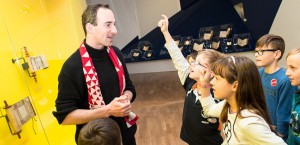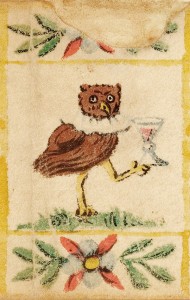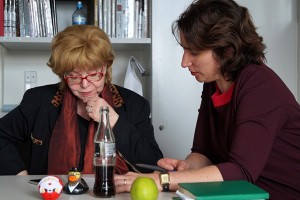
Schoolchildren on a guided tour of the exhibition “The Creation of the World”
© Jewish Museum Berlin, photo: Nadja Rentzsch
“I know!” shouts Tamo* (aged 10): “It’s Jewish writing!” “It’s called Hebrew—Hebrew writing” Mia (aged 10) corrects him. She knows the term because her best friend comes from Israel. She has seen letters like this before, at her friend’s house. Alexander (aged 34) chuckles. He works at the Jewish Museum and is giving a group of primary schoolchildren from Berlin a tour of “The Creation of the World,” our current temporary exhibition. On display are historical manuscripts and artful illustrations. → continue reading
Preparing for the Educational Program on the Exhibition “The Creation of the World”

Detail from a Megilla (Esther scroll), 1750-1800, Alsace
© Braginsky Collection, Zurich, photo: Ardon Bar-Hama
As a part of the educational program accompanying the exhibition “The Creation of the World: Illustrated Manuscripts from the Braginsky Collection” we’re offering the workshop “But the Snake was Craftier…” about telling and passing down stories from generation to generation. Since very few of the schoolchildren who will participate in the workshop can read Hebrew, we’ll be looking closely at the illustrations. In addition to portrayals of David with the harp and Adam and Eve in the manuscripts, our program looks at the megillot, or Esther scrolls, with their illustrations. Six scrolls have been unrolled to their full length for the exhibition.
Before we take participants in to see the exhibition, a guide will tell the story of Esther. During this conscious act of listening, each person generates pictures in his or her own mind’s eye. Afterwards, the group visits the exhibition and looks at the Esther scrolls with a magnifying glass to re-discover the scenes they’ve heard about.
To prepare for this workshop, we consulted a storytelling expert. Ten museum employees met with Prof. Dr. Kristin Wardetzky to practice storytelling under her tutelage. The first chairwoman of the Society for the Art of Storytelling, Prof. Wardetzky also founded the storytelling department at the Berlin University of the Arts’ theater education department.
Our two-day workshop with Prof. Wardetzky enthralled us all. → continue reading
An Interview with Cilly Kugelmann about the Exhibition “The Creation of the World: Illustrated Manuscripts from the Braginsky Collection”
Mirjam Wenzel: At the forthcoming exhibition, the Jewish Museum Berlin will present its first ever show of outstanding examples of the centuries-old Jewish scriptural tradition. What significance does scripture—the written word—have in the Jewish tradition?

Cilly Kugelmann and Mirjam Wenzel
© Jewish Museum Berlin, photo: Katrin Möller
Cilly Kugelmann: In early collections of rabbinic interpretations of biblical texts—the so-called midrashim—it is written that the Torah existed before the world was created. Some rabbis see the Torah quasi as a manual of creation that God drew on during his seven-day feat. Such interpretations demonstrate the extraordinary significance attributed to scripture in Judaism.
Following the loss of the geographic homeland Israel, sacrifices and pilgrimages to specific temples were abandoned in favor of prayer services that could take place anywhere—and the traditional texts themselves consequently became the most important, pivotal moment of the rite. To this day, the study and interpretation of biblical writings is the primary focus of Jewish intellectual life.
Why is René Braginsky’s Collection of illuminated manuscripts being presented under the title “The Creation of the World?” → continue reading


